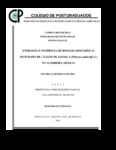Etiología e incidencia de hongos asociados al manchado de cálices de jamaica (Hibiscus sabdariffa L) en Guerrero, México
Abstract
El cultivo de la jamaica (Hibiscus sabdariffa L) es una de las actividades agrícolas importantes en el estado de Guerrero, así como una de las principales fuentes de ingresos monetarios y una alternativa para la diversificación de la actividad agrícola de la región. Este cultivo, en las zonas productoras de Guerrero, se ha visto afectado en los años recientes, por una enfermedad que se caracteriza por un manchado en la superficie del cáliz, situación que afecta a los productores a la hora de comercializar el producto. Por esta razón se realizó el presente trabajo de investigación con la finalidad de conocer los causantes de la enfermedad así como la incidencia y severidad. Los hongos que se asocian a la enfermedad son Coniella musaiaensis (Sutton) var. hibisci, Lasiodiplodia theobromae (Pat.) Griff. & Maubl, Corynespora cassiicola (Berk. & Curt.) Wei y Phomopsis sp. Dearn. La incidencia final de la enfermedad en Huamuchitos fue de 75 %, y en Xalpatláhuac fue de 59 %. Con una severidad final de 42 % y 18.6 % en Huamuchitos y Xalpatláhuac, respectivamente. _______________ ETIOLOGY AND INCIDENCE OF ASOSSCIATED FUNGY OF SPOTTED CALYCES OF ROSELLE (Hibiscus sabdariffa L.) IN GUERRERO, MÉXICO. ABSTRACT: The crop of roselle (Hibiscus sabdariffa L) is one of the major agricultural activities in Guerrero, as well as a major source of monetary income and an alternative for diversification of agriculture in the region. This crop, in the producing areas of Guerrero, has been affected in recent years, a disease characterized by a spotted on the surface of the cup, which affects producers when marketing the product. For this reason was made this research with the purpose of ascertaining the cause of the disease and the incidence and severity. The fungi that are associated with the disease are Coniella musaiaensis (Sutton) var. hibisci, Lasiodiplodia theobromae (Pat.) Griff. & Maubl, Corynespora cassiicola (Berk. & Curt.) Wei and Phomopsis sp. Dearn. The final incidence of disease was 75% Huamuchitos, and Xalpatláhuac was 59%. With a final severity of 42 % and 18.6 % in Huamuchitos and Xalpatláhuac, respectively.
Collections
- Tesis MC, MT, MP y DC [221]

